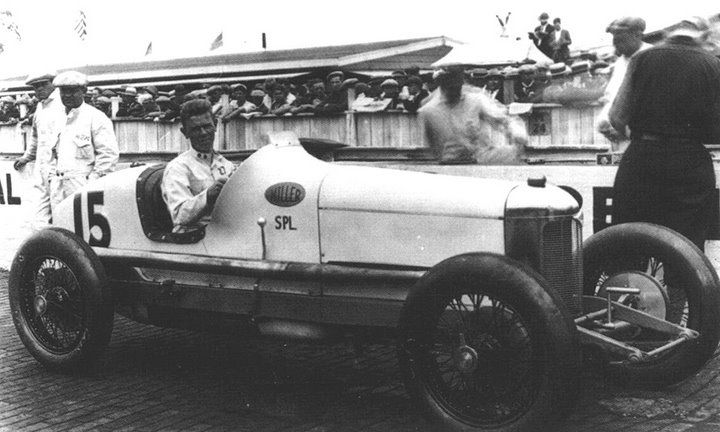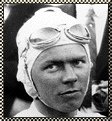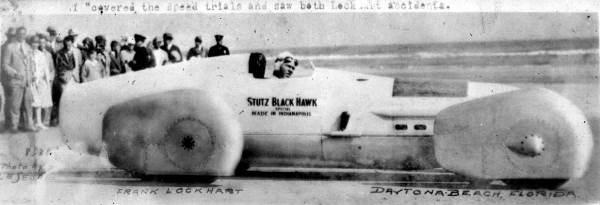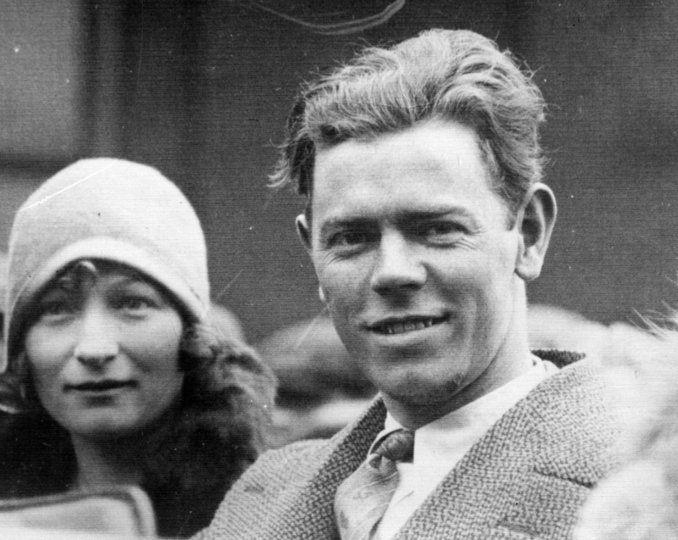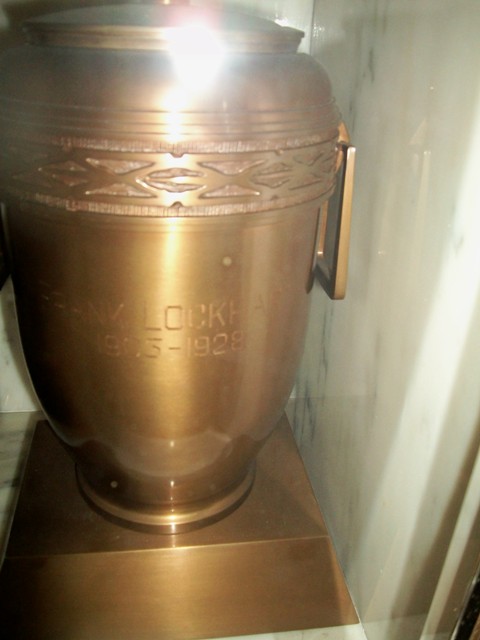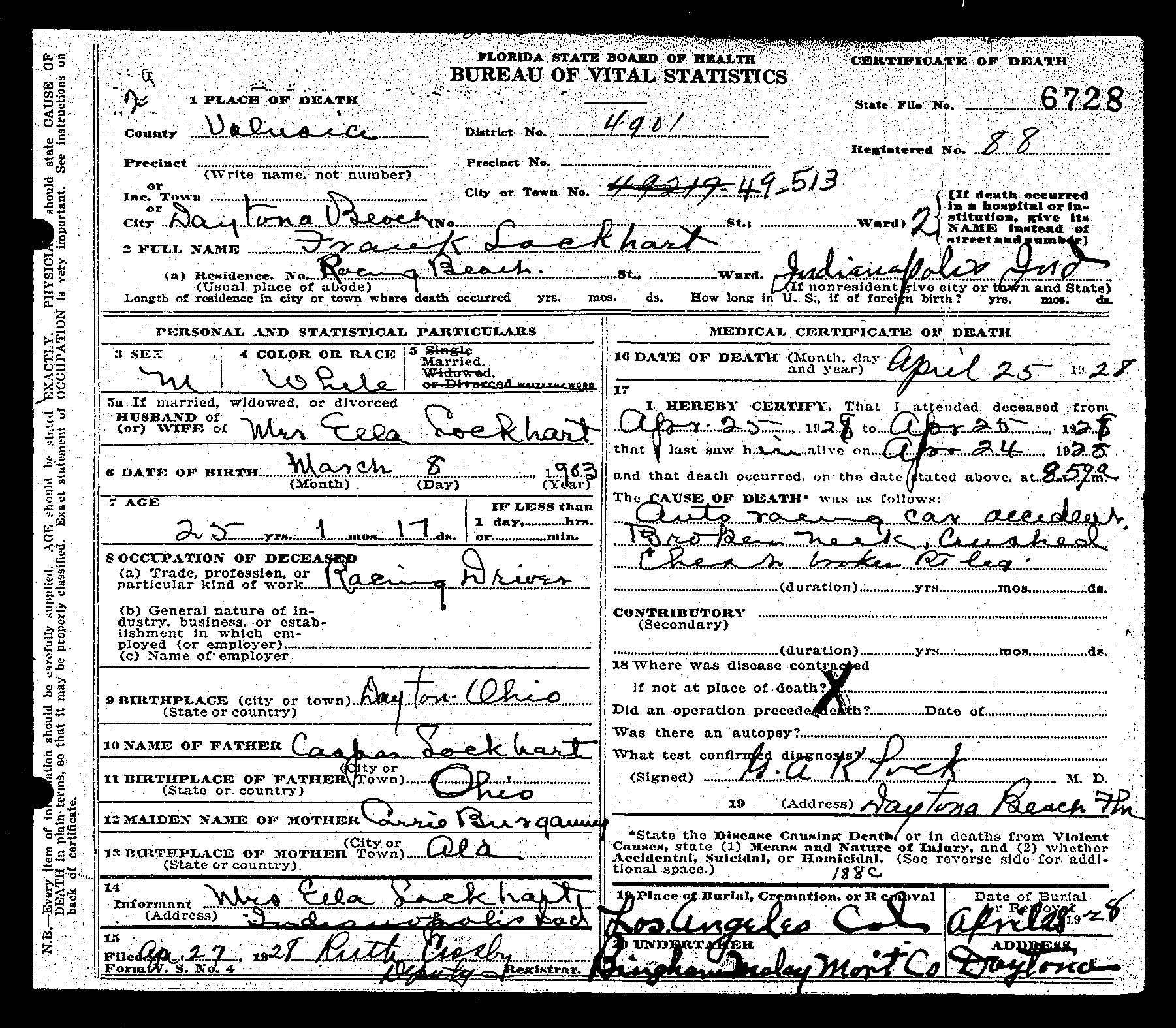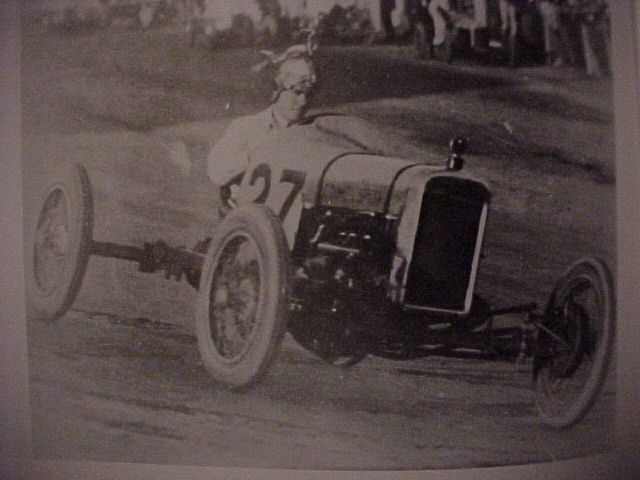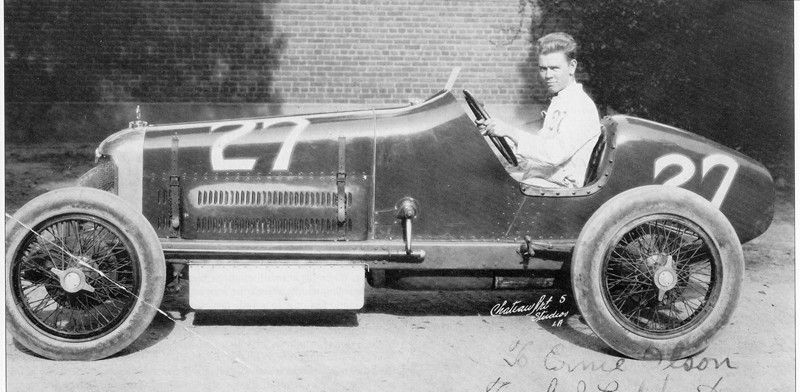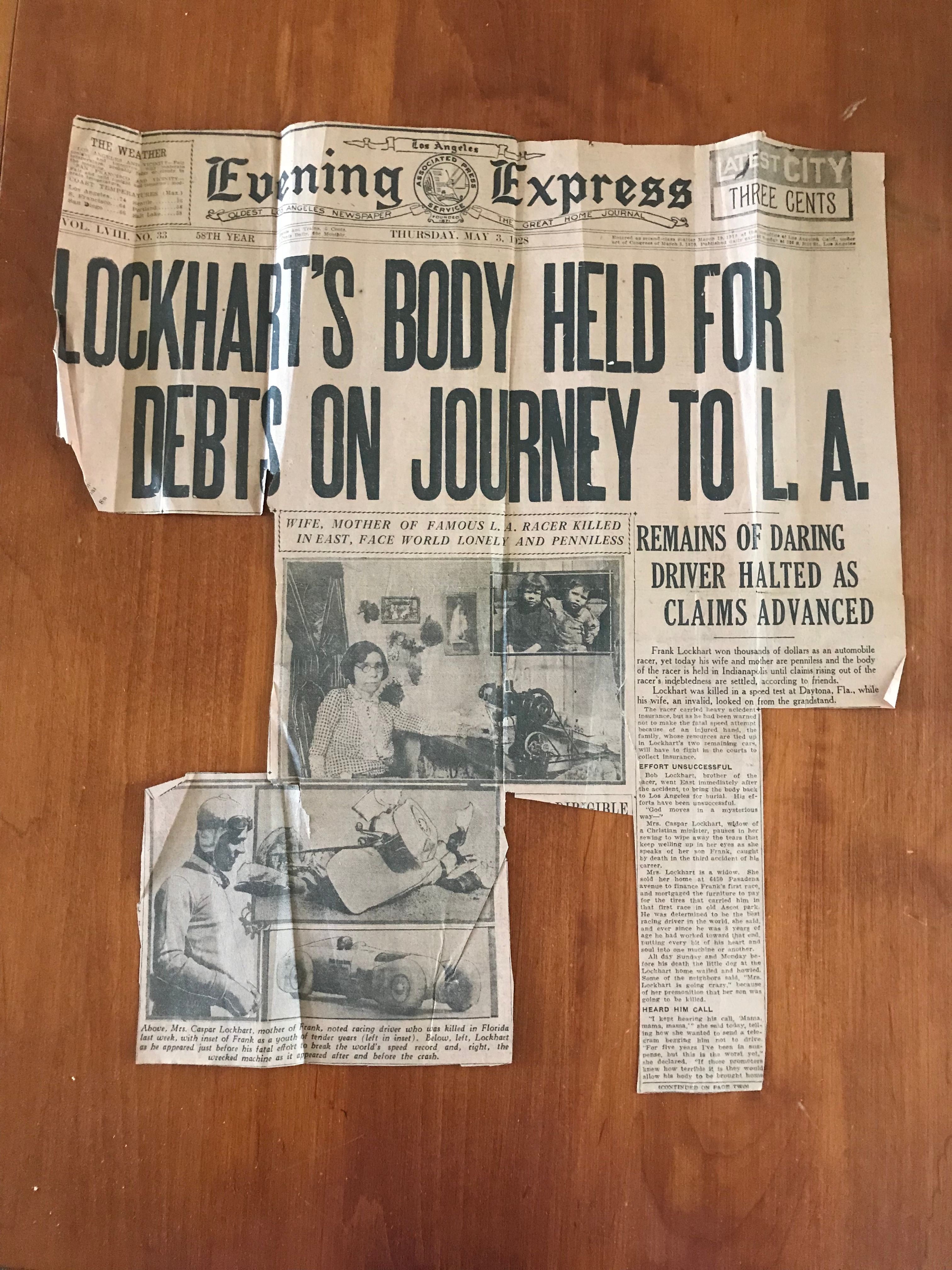"Cremated. Interred in the Columbarium of Faith, Dahlia Terrace, Niche #5938."
--Submitted by Kathy Salazar
* * * * *
Frank Lockhart was an American automobile racing driver, and Indianapolis 500 winner, and considered a legend in the sport by many historians. He had nine AAA wins and two vice-championships in two years.
Lockhart was raised in Southern California. He became a famous West Coast dirt track racer. Lockhart had a strong engineering and motor building ability that he used to build custom cars throughout his career.
Lockhart began his career in Frontenac-prepared Fords (Fronty Fords) at board track racing events, where he showed remarkable speed against the dominating Duesenbergs and Millers for two seasons. His big break came when he was signed as a relief driver for Peter Kreis's eight-cylinder supercharged Miller at the 1926 Indianapolis 500. He convinced Kreis to allow him to take some "warm up" laps, and he clocked quicker times than Kreis (120.919 mph {194.59 km/h}). He set a new unofficial track record on his first official qualifying lap (a three lap average was used to set a track record). He cut down a tire and crashed on the second qualifying lap. He also had mechanical problems on his second attempt. He slowed down on his third and final attempt, and qualified 20th overall with a speed of 95.780 mph (154.113 km/h). On race day, he moved from 20th to fifth by Lap 5, having had passed 14 cars on that lap alone. He moved up to second on Lap 16. Lockhart took the lead from Dave Lewis shortly after a rain delay on Lap 72. Lewis and Lockhart battled for the lead for the next 20 laps, until Lewis dropped out. Lockhart nearly stretched out a two-lap lead before rain ended the race on Lap 160, becoming the fourth rookie to win the Indianapolis 500.
Lockhart bought the car. He later bought a second Miller car, and he set track records almost everywhere he went. He won four more AAA championship events in 1926, and finished second in the standings.
Lockhart's car was the first car equipped with an intercooler. The intercooler added 8 mph (13 km/h) to his speed at his first race at Culver City in March.
Lockhart qualified on the pole for the 1927 Indianapolis 500 in his Perfect Circle Miller. Lockhart led the opening 81 laps, and a full 107 before his car broke a connecting rod, setting an opening lap-leader record that stood for 64 years. He finished 18th. He won five more AAA championship events in 1927, and repeated the vice-championship.
In his racing career he set the all-time qualifying speed record at Atlantic City, a record first exceeded at Indianapolis in 1960. He raced at 22 board track events in his career, with eight wins and fourteen Top 5 finishes, and is 25th on the all-time lap leader board at Indianapolis.
Lockhart took one of his tiny 91 cubic inch (1491 cc) supercharged, intercooled Millers out at the Muroc dry lake and set a land speed record of 160.01 mph (257.50 km/h) for a two-way average in the mile (1.6 km), with a peak speed of 171 mph (275 km/h).
Backed by Stutz Motor Company, Lockhart combined two supercharged 91 ci (1.5 L) DOHC Miller motors, producing about 380 hp (280 kW), the smallest-displacement car ever to make the attempt, to set a new land speed record in the 122-183 cubic inch (2-3 litre) class at Daytona Beach. On April 25, 1928, Lockhart's Stutz Black Hawk Special streamliner (named for the Indiana town that was home to Stutz's factory) turned a warmup run of 198.29 mph (319.1 km/h), with his first official pass at 203.45 mph (327.40 km/h), well below the 207.552 mph (334.007 km/h) mark set earlier in the year by Ray Keech in his 81 litre (4,178 ci) Triplex Special. On Lockhart's return pass the Black Hawk Special cut a tire (probably on a seashell), went out of control and tumbled violently across the sand, throwing Lockhart from the car and killing him instantly.
Lockhart was inducted in the National Sprint Car Hall of Fame in the first class in 1990. He was inducted in the Motorsports Hall of Fame of America in 1999.
"Cremated. Interred in the Columbarium of Faith, Dahlia Terrace, Niche #5938."
--Submitted by Kathy Salazar
* * * * *
Frank Lockhart was an American automobile racing driver, and Indianapolis 500 winner, and considered a legend in the sport by many historians. He had nine AAA wins and two vice-championships in two years.
Lockhart was raised in Southern California. He became a famous West Coast dirt track racer. Lockhart had a strong engineering and motor building ability that he used to build custom cars throughout his career.
Lockhart began his career in Frontenac-prepared Fords (Fronty Fords) at board track racing events, where he showed remarkable speed against the dominating Duesenbergs and Millers for two seasons. His big break came when he was signed as a relief driver for Peter Kreis's eight-cylinder supercharged Miller at the 1926 Indianapolis 500. He convinced Kreis to allow him to take some "warm up" laps, and he clocked quicker times than Kreis (120.919 mph {194.59 km/h}). He set a new unofficial track record on his first official qualifying lap (a three lap average was used to set a track record). He cut down a tire and crashed on the second qualifying lap. He also had mechanical problems on his second attempt. He slowed down on his third and final attempt, and qualified 20th overall with a speed of 95.780 mph (154.113 km/h). On race day, he moved from 20th to fifth by Lap 5, having had passed 14 cars on that lap alone. He moved up to second on Lap 16. Lockhart took the lead from Dave Lewis shortly after a rain delay on Lap 72. Lewis and Lockhart battled for the lead for the next 20 laps, until Lewis dropped out. Lockhart nearly stretched out a two-lap lead before rain ended the race on Lap 160, becoming the fourth rookie to win the Indianapolis 500.
Lockhart bought the car. He later bought a second Miller car, and he set track records almost everywhere he went. He won four more AAA championship events in 1926, and finished second in the standings.
Lockhart's car was the first car equipped with an intercooler. The intercooler added 8 mph (13 km/h) to his speed at his first race at Culver City in March.
Lockhart qualified on the pole for the 1927 Indianapolis 500 in his Perfect Circle Miller. Lockhart led the opening 81 laps, and a full 107 before his car broke a connecting rod, setting an opening lap-leader record that stood for 64 years. He finished 18th. He won five more AAA championship events in 1927, and repeated the vice-championship.
In his racing career he set the all-time qualifying speed record at Atlantic City, a record first exceeded at Indianapolis in 1960. He raced at 22 board track events in his career, with eight wins and fourteen Top 5 finishes, and is 25th on the all-time lap leader board at Indianapolis.
Lockhart took one of his tiny 91 cubic inch (1491 cc) supercharged, intercooled Millers out at the Muroc dry lake and set a land speed record of 160.01 mph (257.50 km/h) for a two-way average in the mile (1.6 km), with a peak speed of 171 mph (275 km/h).
Backed by Stutz Motor Company, Lockhart combined two supercharged 91 ci (1.5 L) DOHC Miller motors, producing about 380 hp (280 kW), the smallest-displacement car ever to make the attempt, to set a new land speed record in the 122-183 cubic inch (2-3 litre) class at Daytona Beach. On April 25, 1928, Lockhart's Stutz Black Hawk Special streamliner (named for the Indiana town that was home to Stutz's factory) turned a warmup run of 198.29 mph (319.1 km/h), with his first official pass at 203.45 mph (327.40 km/h), well below the 207.552 mph (334.007 km/h) mark set earlier in the year by Ray Keech in his 81 litre (4,178 ci) Triplex Special. On Lockhart's return pass the Black Hawk Special cut a tire (probably on a seashell), went out of control and tumbled violently across the sand, throwing Lockhart from the car and killing him instantly.
Lockhart was inducted in the National Sprint Car Hall of Fame in the first class in 1990. He was inducted in the Motorsports Hall of Fame of America in 1999.
Family Members
Sponsored by Ancestry
Advertisement
Records on Ancestry
Advertisement








